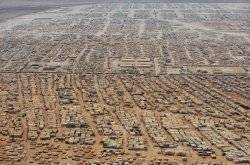An estimated 250,000 people in besieged communities in Syria remain beyond the reach of aid, the UN, humanitarian chief has said in a closed-door Security Council briefing that one member called "chilling."
Deep divisions in the council have kept it from taking more action on the civil war that activists say has killed more than 120,000 people.
Valerie Amos' task has been to tell the world body about the worsening conditions for millions of civilians in Syria, and how difficult it is to reach them.
Amos was able to report "modest progress" in such basics as getting 50 more long-demanded visas for aid workers and opening three humanitarian hubs inside Syria, "only two of which are helpful to us."
But "we have not seen any progress'' in the major issues of protecting civilians and demilitarizing schools and hospitals, Amos said.
Last month, she told the council that the number of Syrians in need of humanitarian assistance has risen dramatically to 9.3 million people, up from 6.8 million in June.
Against those numbers, she said the Syrian government approved nine aid convoys last month, up from the usual three.
"This is still far too few to meet the needs of millions of people," Amos said.
For those that do have access to aid, what there is is stretched very thin, highlighted by the fact that international aid workers have been rushing to prepare the Zaatari camp, a Syrian refugee camp in Jordan attempting to avoid repeat of last year when three days of torrential rain turned the camp into a muddy swamp.
Warm clothing, blankets and electric heaters are being prepared for distribution to the desert camp's 120,000 residents, mostly women and children.
In January 2013, howling winds tore down some tents and flooding piled more misery on those who fled Syria's civil war.
Hundreds were displaced from their temporary shelters in the Zaatari camp which is 14km south of the Syrian border.
Exposed to freezing temperatures, some refugees attacked aid workers at a food distribution center, injuring a dozen before being dispersed by Jordanian riot police.
Lessons learnt
A drainage system was set up to dump floodwaters outside the camp and efforts are being made to keep the refugees warm and dry, said Kilian Kleinschmidt, who runs Zaatari for the UN refugee agency.
In Zaatari many of the plastic tents will be replaced in the coming weeks with prefabricated trailers donated by Gulf Arab states, said Andy Needham, a press officer with the UN refugee agency.
He said he has been waiting for a trailer for 14 months.
UNICEF, the UN agency helping refugee children, is contributing to the effort in Jordan and other host countries.
In Zaatari, UNICEF is providing 35,000 clothing kits which include scarves, hats, sweaters and boots, as well as 24,000 blankets, said communications officer Melanie Sharpe.
PHOTO CAPTION
An aerial view shows the Zaatari refugee camp, near the Jordanian city of Mafraq July 18, 2013.
Aljazeera


 Home
Home Discover Islam
Discover Islam Quran Recitations
Quran Recitations Lectures
Lectures
 Fatwa
Fatwa Articles
Articles Fiqh
Fiqh E-Books
E-Books Boys & Girls
Boys & Girls  Women
Women










